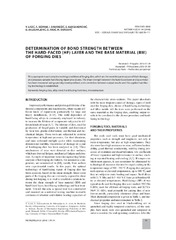| dc.creator | Lazić, Vukić | |
| dc.creator | Sedmak, Aleksandar | |
| dc.creator | Samardžić, I. | |
| dc.creator | Aleksandrović, Srbislav | |
| dc.creator | Milosavljević, Dragan I. | |
| dc.creator | Arsić, D. | |
| dc.creator | Đorđević, M. | |
| dc.date.accessioned | 2022-09-19T17:53:02Z | |
| dc.date.available | 2022-09-19T17:53:02Z | |
| dc.date.issued | 2016 | |
| dc.identifier.issn | 0543-5846 | |
| dc.identifier.uri | https://machinery.mas.bg.ac.rs/handle/123456789/2313 | |
| dc.description.abstract | This paper points out complex working conditions of forging dies, which are the most frequent causes of their damage, and proposes suitable hard-facing repair procedures. The shear strength between the hard-faced layer and base metal has been measured using specially developed tool, and correlation between output results and the applied hard-facing technology is established. | en |
| dc.publisher | Faculty of Metallurgy | |
| dc.relation | info:eu-repo/grantAgreement/MESTD/Technological Development (TD or TR)/33015/RS// | |
| dc.relation | info:eu-repo/grantAgreement/MESTD/Technological Development (TD or TR)/35024/RS// | |
| dc.rights | openAccess | |
| dc.rights.uri | https://creativecommons.org/licenses/by/4.0/ | |
| dc.source | Metalurgija | |
| dc.subject | Microstructure | en |
| dc.subject | Hardness | en |
| dc.subject | Hard-facing | en |
| dc.subject | Forging dies | en |
| dc.subject | Alloy steel | en |
| dc.title | Determination of bond strength between the hard-faced (HF) layer and the base material (BM) of forging dies | en |
| dc.type | article | |
| dc.rights.license | BY | |
| dc.citation.epage | 94 | |
| dc.citation.issue | 1 | |
| dc.citation.other | 55(1): 91-94 | |
| dc.citation.rank | M22 | |
| dc.citation.spage | 91 | |
| dc.citation.volume | 55 | |
| dc.identifier.fulltext | http://machinery.mas.bg.ac.rs/bitstream/id/1066/2310.pdf | |
| dc.identifier.rcub | https://hdl.handle.net/21.15107/rcub_machinery_2313 | |
| dc.identifier.scopus | 2-s2.0-84938402958 | |
| dc.type.version | publishedVersion | |


